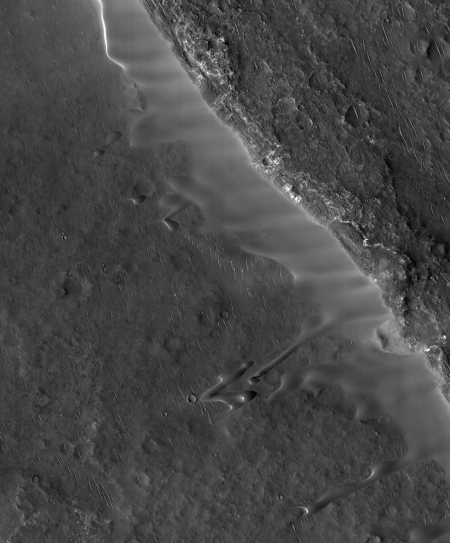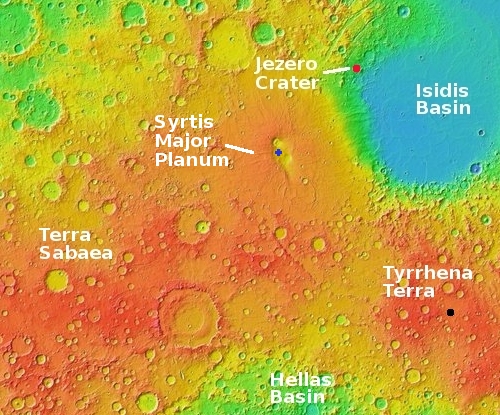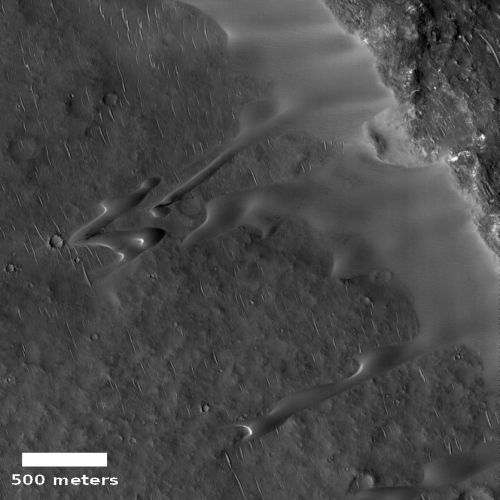Martian sand traps and elongated dunes
Cool image time! The photo to the left, rotated, cropped, and reduced to post here, was taken on June 23, 2020 by the high resolution camera on Mars Reconnaissance Orbiter (MRO). I was attracted by the uncaptioned image’s title, “Elongating Linear Dunes at Meroe Patera.” What are elongating linear dunes?
The photo shows two such dunes, stretching out to the southwest away from the pile of sand that abuts the cliff to the northwest. Unlike most dunes, which usually form and travel in groups, these for some reason form single straight lines extending for some distance.
I contacted the scientist who requested this image, Joel Davis of the Natural History Museum in London, hoping he could answer some questions about these strangely shaped dunes, and discovered that he was studying this exact subject for a paper since published. As noted in the paper’s introduction,
Linear dunes develop in multidirectional wind regimes and may migrate laterally (i.e., crest normal) and by elongation (i.e., crest parallel). Recent laboratory and numerical experiments demonstrate that in sediment‐starved regions (e.g., with nonerodible bedrock), linear dunes develop by elongation at the dune tips, aligned with the mean sediment transport direction (“finger‐mode”.

While on Earth such dunes form “extensive sand seas, linear dunes in nonpolar regions of Mars are rare.” The paper took a close look at multiple images of some these rare elongated dunes on Mars, taken over time, and found that they generally grew along their length, outward, parallel to the prevailing wind. Some were actively growing, some were not. Estimated ages ranged between 1,300 and 5,000 Earth years.
In the image above, as well as the wider shot of the same place to the right, the prevailing winds blow over that ridge, about 100 feet high, flow downward to hit the sand field nestled up against it, catch some of it and blow it outward to form the elongated dunes. As Davis explained, “The southwest side of the ridge is likely acting as a sand trap, where it is protected from the wind. The dunes then extent outwards from this field of sand.”
Imagine thick honey dripping down a shallow slope. Most of it might not move very much, but often a single drip might flow down, stopping when the supply of honey above peters out. In the case of these dunes, it isn’t gravity that is causing the flow, but the prevailing winds.
The wider shot however reveals some mysteries. For some reason the elongated dunes only occur in two specific spots. To the north we have the same ridgeline, the same field of sand sitting up against the ridge, but no elongated dunes. I asked Dr. Davis if there was an explanation for this. His wonderful answer, spoken like a true scientist:
I’m not sure, to be honest. It could be a number of factors due to winds, the availability of sand, or other conditions that make these particular locations ideal for dunes to nucleate.
One explanation that did occur to me (unproven of course) is that there might be a hollow in the ridge aligned with elongated dune, acting as funnel for wind and thus encouraging dune growth at just that point.

The location of these particular dunes on Mars, as shown by the blue cross in the overview map to the right, is interesting in itself. The dunes and ridge sit inside the caldera of one of Mars least dramatic looking shield volcanoes, Syrtis Major Planum, which ironically was the first documented surface feature identified on another planet, discovered by Christiaan Huygens during his observations of Mars in 1659.
This location, near to Jezero Crater where Perseverance will land in February 2021, is nestled between Isidis Basin, formed by a giant impact, and the dry and barren cratered highlands to the south. And like those highlands, I suspect that Syrtis Major is as dry and as barren. Unless someone discovers mineral resources here, the first colonizers of Mars will not come to this place first.
On Christmas Eve 1968 three Americans became the first humans to visit another world. What they did to celebrate was unexpected and profound, and will be remembered throughout all human history. Genesis: the Story of Apollo 8, Robert Zimmerman's classic history of humanity's first journey to another world, tells that story, and it is now available as both an ebook and an audiobook, both with a foreword by Valerie Anders and a new introduction by Robert Zimmerman.
The print edition can be purchased at Amazon or from any other book seller. If you want an autographed copy the price is $60 for the hardback and $45 for the paperback, plus $8 shipping for each. Go here for purchasing details. The ebook is available everywhere for $5.99 (before discount) at amazon, or direct from my ebook publisher, ebookit. If you buy it from ebookit you don't support the big tech companies and the author gets a bigger cut much sooner.
The audiobook is also available at all these vendors, and is also free with a 30-day trial membership to Audible.
"Not simply about one mission, [Genesis] is also the history of America's quest for the moon... Zimmerman has done a masterful job of tying disparate events together into a solid account of one of America's greatest human triumphs."--San Antonio Express-News
Cool image time! The photo to the left, rotated, cropped, and reduced to post here, was taken on June 23, 2020 by the high resolution camera on Mars Reconnaissance Orbiter (MRO). I was attracted by the uncaptioned image’s title, “Elongating Linear Dunes at Meroe Patera.” What are elongating linear dunes?
The photo shows two such dunes, stretching out to the southwest away from the pile of sand that abuts the cliff to the northwest. Unlike most dunes, which usually form and travel in groups, these for some reason form single straight lines extending for some distance.
I contacted the scientist who requested this image, Joel Davis of the Natural History Museum in London, hoping he could answer some questions about these strangely shaped dunes, and discovered that he was studying this exact subject for a paper since published. As noted in the paper’s introduction,
Linear dunes develop in multidirectional wind regimes and may migrate laterally (i.e., crest normal) and by elongation (i.e., crest parallel). Recent laboratory and numerical experiments demonstrate that in sediment‐starved regions (e.g., with nonerodible bedrock), linear dunes develop by elongation at the dune tips, aligned with the mean sediment transport direction (“finger‐mode”.

While on Earth such dunes form “extensive sand seas, linear dunes in nonpolar regions of Mars are rare.” The paper took a close look at multiple images of some these rare elongated dunes on Mars, taken over time, and found that they generally grew along their length, outward, parallel to the prevailing wind. Some were actively growing, some were not. Estimated ages ranged between 1,300 and 5,000 Earth years.
In the image above, as well as the wider shot of the same place to the right, the prevailing winds blow over that ridge, about 100 feet high, flow downward to hit the sand field nestled up against it, catch some of it and blow it outward to form the elongated dunes. As Davis explained, “The southwest side of the ridge is likely acting as a sand trap, where it is protected from the wind. The dunes then extent outwards from this field of sand.”
Imagine thick honey dripping down a shallow slope. Most of it might not move very much, but often a single drip might flow down, stopping when the supply of honey above peters out. In the case of these dunes, it isn’t gravity that is causing the flow, but the prevailing winds.
The wider shot however reveals some mysteries. For some reason the elongated dunes only occur in two specific spots. To the north we have the same ridgeline, the same field of sand sitting up against the ridge, but no elongated dunes. I asked Dr. Davis if there was an explanation for this. His wonderful answer, spoken like a true scientist:
I’m not sure, to be honest. It could be a number of factors due to winds, the availability of sand, or other conditions that make these particular locations ideal for dunes to nucleate.
One explanation that did occur to me (unproven of course) is that there might be a hollow in the ridge aligned with elongated dune, acting as funnel for wind and thus encouraging dune growth at just that point.

The location of these particular dunes on Mars, as shown by the blue cross in the overview map to the right, is interesting in itself. The dunes and ridge sit inside the caldera of one of Mars least dramatic looking shield volcanoes, Syrtis Major Planum, which ironically was the first documented surface feature identified on another planet, discovered by Christiaan Huygens during his observations of Mars in 1659.
This location, near to Jezero Crater where Perseverance will land in February 2021, is nestled between Isidis Basin, formed by a giant impact, and the dry and barren cratered highlands to the south. And like those highlands, I suspect that Syrtis Major is as dry and as barren. Unless someone discovers mineral resources here, the first colonizers of Mars will not come to this place first.
On Christmas Eve 1968 three Americans became the first humans to visit another world. What they did to celebrate was unexpected and profound, and will be remembered throughout all human history. Genesis: the Story of Apollo 8, Robert Zimmerman's classic history of humanity's first journey to another world, tells that story, and it is now available as both an ebook and an audiobook, both with a foreword by Valerie Anders and a new introduction by Robert Zimmerman.
The print edition can be purchased at Amazon or from any other book seller. If you want an autographed copy the price is $60 for the hardback and $45 for the paperback, plus $8 shipping for each. Go here for purchasing details. The ebook is available everywhere for $5.99 (before discount) at amazon, or direct from my ebook publisher, ebookit. If you buy it from ebookit you don't support the big tech companies and the author gets a bigger cut much sooner.
The audiobook is also available at all these vendors, and is also free with a 30-day trial membership to Audible.
"Not simply about one mission, [Genesis] is also the history of America's quest for the moon... Zimmerman has done a masterful job of tying disparate events together into a solid account of one of America's greatest human triumphs."--San Antonio Express-News



Mars is way more interesting than the Moon.
My favorite Mars picture is of Dust Devils recorded by rovers.
https://earthsky.org/upl/2016/04/mars-opportunity-3-31-2016-NASA-e1460025108939.jpg
Hi Bob,
An orientation question. You note:
“The photo shows two such dunes, stretching out to the southwest away from the pile of sand that abuts the cliff to the northwest.”
Are the photos always oriented such that north is always at the top of the photo?
Thanks,
CMcL
Chris: Depends on where on Mars the picture was taken. Images from the equator to the high mid-latitudes will be oriented with north more-or-less up, but at an angle because of the orbit of MRO. At the poles that angle becomes more pronounced.
When I rotate I usually do it to make the area I am cropping vertical, to capture more of it. This generally makes north up.